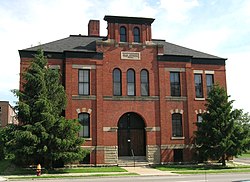| Clay School | |
| U.S. National Register of Historic Places | |
| Michigan State Historic Site | |
 | |
| Location | 453 Martin Luther King, Jr. Boulevard Detroit, Michigan |
|---|---|
| Coordinates | 42°20′42″N 83°3′42″W / 42.34500°N 83.06167°W / 42.34500; -83.06167 |
| Built | 1888 |
| Architect | J.B. Tarleton |
| Architectural style | Late Victorian |
| NRHP reference No. | 82002913 |
| Significant dates | |
| Added to NRHP | July 8, 1982 |
| Designated MSHS | September 8, 1982 |
The Clay Office and Conference Center is a renovated office complex formerly known as the Clay School. It is located at 453 Martin Luther King, Jr. Boulevard in Midtown Detroit, Michigan. It is the oldest school building in the city of Detroit. It was listed on the National Register of Historic Places and designated a Michigan State Historic Site in 1982.
History
In 1873, a frame schoolhouse was built at this location to serve the children living in the area. In 1888, the frame school was moved to the north side of the city and replaced by the current structure. The building was designed by architect J.B. Tarleton, who served as the architect for the Detroit Board of Education from 1884 to 1890. This is the only school he designed that is still standing.
The building served as an elementary school until 1923. For the next eight years, it was a center for boys with discipline problems, and it was later used as headquarters for vocational study and as administrative offices for the Practical Nursing Center. In 1981, the building was sold to a developer, who converted the building into office space.
Architecture
The Clay School is a two-story brick structure, measuring 72 feet by 80 feet, with a high basement and hipped roof. The basement is marked at the top with a line of exterior stones. The front facade has a central pavilion with an arched entryway decorated in stone. The central projecting tower was originally topped with a wooden cupola, which was removed in the 1970s.
Inside, the first and second floors each contain four classrooms with coat rooms. The basement level contains the boiler room and bathrooms. The interior contains the original trim, including beaded wainscoting in the hallways, wooden classroom doors with transoms, molded window and door trim, high baseboards and hardwood floors.
References
- ^ "National Register Information System". National Register of Historic Places. National Park Service. April 15, 2008.
- "Clay School". Michigan State Housing Development Authority. Archived from the original on May 17, 2012. Retrieved September 2, 2010.
- ^ Clay School from Detroit1701
- Hill, Eric J. and John Gallagher (2002). AIA Detroit: The American Institute of Architects Guide to Detroit Architecture. Wayne State University Press. ISBN 0-8143-3120-3. P. 128.
- ^ Brian Conway (March 30, 1982), National Register of Historic Places Inventory-Nomination Form: The Clay School
- Clay Office and Conference Center Archived 2007-08-14 at archive.today from Woodward Avenue
| Architecture of metropolitan Detroit | ||||||||||||||||||||||
|---|---|---|---|---|---|---|---|---|---|---|---|---|---|---|---|---|---|---|---|---|---|---|
| Skyscrapers |
|  | ||||||||||||||||||||
| Low rise under 10 stories selected |
| |||||||||||||||||||||
| Parks and gardens | ||||||||||||||||||||||
| Museums and libraries |
| |||||||||||||||||||||
| Religious landmarks | ||||||||||||||||||||||
| Performance centers | ||||||||||||||||||||||
| Neighborhood Historic Districts |
| |||||||||||||||||||||
| See also: List of tallest buildings in Detroit | ||||||||||||||||||||||
| National Register of Historic Places in Michigan | ||
|---|---|---|
| Lists by county |
|   |
| Other lists | ||